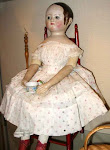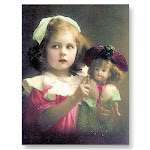 From the time of Francis 1 of France (ca.1540) doll makers always used a mixture of clay, paper and plaster. By the 18th century German communities had master the art, and became important manufacturers of toys alongside the towns of France. Particularly noted were the communities of Sonnenberg, and Nuremberg, which developed from insignificant country towns. In Nuremberg alone there were seventeen workshops devoted to toy-making
From the time of Francis 1 of France (ca.1540) doll makers always used a mixture of clay, paper and plaster. By the 18th century German communities had master the art, and became important manufacturers of toys alongside the towns of France. Particularly noted were the communities of Sonnenberg, and Nuremberg, which developed from insignificant country towns. In Nuremberg alone there were seventeen workshops devoted to toy-making(King, p. 56).



 Dolls with typical clothes ca. 1800 and 1820
Dolls with typical clothes ca. 1800 and 1820
Nuremberg has more than 600 years of tradition as a city of toys. Production of and trade in toys are an integral part of the city’s general industrial history, but they are also an important part of Europe’s cultural history of toys because of their economic and cultural influence. This history spans from the beginnings of recorded doll production in Nuremberg towards the end of the 14th century, to the ever more sophisticated craft of toy production in the pre-industrial age, and right up to the industrial mass production of metal toys in 19th and 20th century.
Part of the reason for their prominence was their location.
Most were located near the large forests of Thuringia which provided the raw materials for toys,
as well as their access to local paper mills.
as well as their access to local paper mills.













































.jpg)


































































I'd would never dare to show you photos of my Silkstone Barbies! They look so vanal...
ReplyDeleteI love the clothes of the 5th photo dolls, and the b&w photo doll.
I´m learning a lot with your blog! You are such a smart girl!
Hugs.
You are very kind...I am learning myself a lot doing all this research. Its very rewarding.
ReplyDeleteThanks!